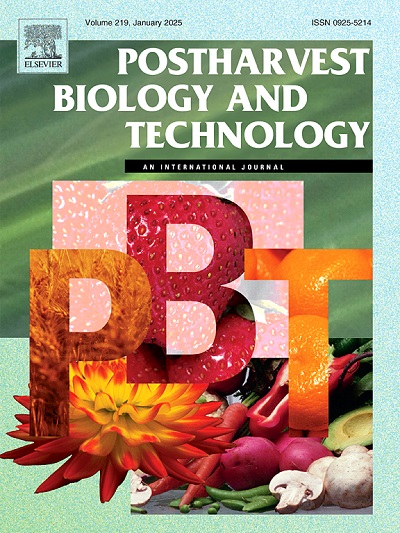Genome-wide analysis of TGACG motif-binding factor (TGA) family and mechanism of PpTGA2.1-L and PpTGA7-L response to salicylic acid regulating fruit senescence through interaction with PpNPR1 in sand pear
IF 6.4
1区 农林科学
Q1 AGRONOMY
引用次数: 0
Abstract
Sand pear fruit are well-regarded for their rich nutritional content and desirable flavor. Despite their popularity, their limited postharvest longevity poses a challenge for commercial distribution. Research has demonstrated that salicylic acid (SA) can effectively slow down fruit senescence processes and enhance storage duration. However, there is limited research on the interaction between TGA proteins and the SA receptor protein NPR1 in the regulation of fruit senescence. In this study, 14 TGA genes were identified in sand pear. Transcriptomic analysis revealed two genes (PpTGA2.1-L and PpTGA7-L). The 14 TGA proteins in sand pear were divided into five subgroups. PpTGA2.1-L and PpTGA7-L exhibited distinct expression patterns across various sand pear tissues, with both genes showing preferential expression levels during the fruit senescence stage. Exogenous SA treatment up-regulated the expression of PpTGA2.1-L while down-regulating the expression of PpTGA7-L. Further experiments using yeast two-hybrid and luciferase assays confirmed that both PpTGA2.1-L and PpTGA7-L interact with PpNPR1. Functional analysis revealed that PpTGA2.1-L delayed sand pear fruit senescence, whereas PpTGA7-L had the opposite effect. Further investigations demonstrated that PpTGA2.1-L, in coordination with the SA receptor NPR1, enhances the activities of antioxidant enzymes peroxidase, superoxide dismutase, and catalase, increases the content of SA, while reducing the accumulation of malondialdehyde, ethylene, polygalacturonase, pectin methyl ester, and cellulase, thus delaying fruit senescence. SA treatment further delays fruit senescence. In contrast, PpTGA7-L modulates the senescence process by antagonizing the action of PpNPR1. This senescence process was delayed after SA treatment. In conclusion, the results of this study revealed that PpTGA2.1-L and PpTGA7-L play key roles in pear fruit senescence by interacting with PpNPR1 through the SA signaling pathway.
沙梨TGACG基序结合因子(TGA)家族全基因组分析及PpTGA2.1-L和PpTGA7-L通过与PpNPR1互作响应水杨酸调控果实衰老的机制
沙梨果实以其丰富的营养成分和令人向往的风味而备受推崇。尽管它们很受欢迎,但采后寿命有限,这对商业分销构成了挑战。研究表明,水杨酸能有效延缓果实衰老,延长贮藏期。然而,TGA蛋白与SA受体蛋白NPR1相互作用调控果实衰老的研究有限。本研究共鉴定出沙梨中14个TGA基因。转录组学分析显示两个基因(PpTGA2.1-L和PpTGA7-L)。沙梨中14个TGA蛋白可分为5个亚群。PpTGA2.1-L和PpTGA7-L在沙梨各组织中表达模式不同,在果实衰老阶段均表现出优先表达水平。外源SA处理上调PpTGA2.1-L的表达,下调PpTGA7-L的表达。进一步的酵母双杂交和荧光素酶实验证实PpTGA2.1-L和PpTGA7-L与PpNPR1相互作用。功能分析显示,PpTGA2.1-L具有延缓沙梨果实衰老的作用,而PpTGA7-L具有相反的作用。进一步研究表明,PpTGA2.1-L通过与SA受体NPR1协同作用,增强抗氧化酶过氧化物酶、超氧化物歧化酶和过氧化氢酶的活性,增加SA含量,同时减少丙二醛、乙烯、聚半乳糖醛酸酶、果胶甲酯和纤维素酶的积累,从而延缓果实衰老。SA处理进一步延缓了果实的衰老。相反,PpTGA7-L通过拮抗PpNPR1的作用来调节衰老过程。这种衰老过程在SA处理后延迟。综上所述,本研究结果表明PpTGA2.1-L和PpTGA7-L通过SA信号通路与PpNPR1相互作用,在梨果实衰老过程中发挥关键作用。
本文章由计算机程序翻译,如有差异,请以英文原文为准。
求助全文
约1分钟内获得全文
求助全文
来源期刊

Postharvest Biology and Technology
农林科学-农艺学
CiteScore
12.00
自引率
11.40%
发文量
309
审稿时长
38 days
期刊介绍:
The journal is devoted exclusively to the publication of original papers, review articles and frontiers articles on biological and technological postharvest research. This includes the areas of postharvest storage, treatments and underpinning mechanisms, quality evaluation, packaging, handling and distribution of fresh horticultural crops including fruit, vegetables, flowers and nuts, but excluding grains, seeds and forages.
Papers reporting novel insights from fundamental and interdisciplinary research will be particularly encouraged. These disciplines include systems biology, bioinformatics, entomology, plant physiology, plant pathology, (bio)chemistry, engineering, modelling, and technologies for nondestructive testing.
Manuscripts on fresh food crops that will be further processed after postharvest storage, or on food processes beyond refrigeration, packaging and minimal processing will not be considered.
 求助内容:
求助内容: 应助结果提醒方式:
应助结果提醒方式:


